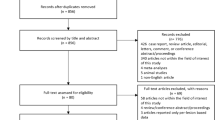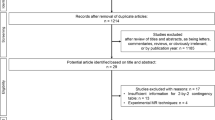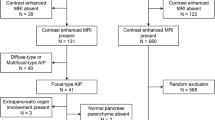Abstract
Objectives
To intraindividually compare the diagnostic performance of CT and MRI in differentiating non-diffuse-type autoimmune pancreatitis (AIP) from pancreatic ductal adenocarcinoma (PDA).
Methods
Sixty-one patients with non-diffuse-type AIP and 122 patients with PDA, who underwent dynamic contrast-enhanced CT and MRI with MR pancreatography, were included. Two blinded radiologists independently rated their confidence in differentiating the two diseases on a 5-point scale, and the diagnostic performances of CT and MRI were compared. The presence of key imaging features to differentiate AIP and PDA were compared between CT and MRI.
Results
The area under the receiver operating characteristic curve was significantly greater on MRI (0.993–0.995) than on CT (0.953–0.976) for both raters (p≤0.035). The sensitivities of MRI were higher than those of CT for the diagnosis of AIP (88.5–90.2% vs. 77–80.3%, p≤0.07) and PDA (97.5–99.2% vs. 91.8–94.3%, p≤0.031) for both raters, although the difference for AIP was statistically marginal (p=0.07) for rater 1. In AIP, multiple pancreatic masses, delayed homogeneous enhancement of the pancreatic mass, and multiple main pancreatic duct (MPD) strictures were observed significantly more frequently using MRI than CT (p≤0.008). In PDA, discrete pancreatic mass and MPD stricture were observed significantly more frequently using MRI than CT (p≤0.012).
Conclusions
The diagnostic performance of MRI is better for differentiating non-diffuse-type AIP from PDA, which is due to the superiority of MRI over CT in demonstrating the key distinguishing features of both diseases.
Key Points
• Imaging differential diagnosis of non-diffuse-type AIP and PDA is challenging.
• MRI has better diagnostic performance than CT in differentiating non-diffuse-type AIP from PDA.
• MRI is superior to CT in demonstrating key distinguishing features of non-diffuse-type AIP and PDA.



Similar content being viewed by others
Abbreviations
- AIP:
-
Autoimmune pancreatitis
- IgG:
-
Immunoglobulin G
- MPD:
-
Main pancreatic duct
- MRP:
-
Magnetic resonance pancreatography
- PDA:
-
Pancreatic ductal adenocarcinoma
References
Finkelberg DL, Sahani D, Deshpande V, Brugge WR (2006) Autoimmune pancreatitis. N Engl J Med 355:2670–2676
Chari ST, Takahashi N, Levy MJ et al (2009) A diagnostic strategy to distinguish autoimmune pancreatitis from pancreatic cancer. Clin Gastroenterol Hepatol 7:1097–1103
Kamisawa T, Imai M, Yui Chen P et al (2008) Strategy for differentiating autoimmune pancreatitis from pancreatic cancer. Pancreas 37:e62–e67
Kim JH, Kim MH, Byun JH et al (2012) Diagnostic Strategy for Differentiating Autoimmune Pancreatitis From Pancreatic Cancer: Is an Endoscopic Retrograde Pancreatography Essential? Pancreas 41:639–647
Choi SY, Kim SH, Kang TW, Song KD, Park HJ, Choi YH (2016) Differentiating Mass-Forming Autoimmune Pancreatitis From Pancreatic Ductal Adenocarcinoma on the Basis of Contrast-Enhanced MRI and DWI Findings. AJR Am J Roentgenol 206:291–300
Hur BY, Lee JM, Lee JE et al (2012) Magnetic resonance imaging findings of the mass-forming type of autoimmune pancreatitis: Comparison with pancreatic adenocarcinoma. J Magn Reson Imaging 36:188–197
Rehnitz C, Klauss M, Singer R et al (2011) Morphologic Patterns of Autoimmune Pancreatitis in CT and MRI. Pancreatology 11:240–251
Kim HJ, Kim YK, Jeong WK, Lee WJ, Choi D (2015) Pancreatic duct "Icicle sign" on MRI for distinguishing autoimmune pancreatitis from pancreatic ductal adenocarcinoma in the proximal pancreas. Eur Radiol 25:1551–1560
Negrelli R, Manfredi R, Pedrinolla B et al (2015) Pancreatic duct abnormalities in focal autoimmune pancreatitis: MR/MRCP imaging findings. Eur Radiol 25:359–367
Muhi A, Ichikawa T, Motosugi U et al (2012) Mass-forming autoimmune pancreatitis and pancreatic carcinoma: Differential diagnosis on the basis of computed tomography and magnetic resonance cholangiopancreatography, and diffusion-weighted imaging findings. J Magn Reson Imaging 35:827–836
Kim M, Jang KM, Kim JH et al (2017) Differentiation of mass-forming focal pancreatitis from pancreatic ductal adenocarcinoma: value of characterizing dynamic enhancement patterns on contrast-enhanced MR images by adding signal intensity color mapping. Eur Radiol 27:1722–1732
Furuhashi N, Suzuki K, Sakurai Y, Ikeda M, Kawai Y, Naganawa S (2015) Differentiation of focal-type autoimmune pancreatitis from pancreatic carcinoma: assessment by multiphase contrast-enhanced CT. Eur Radiol 25:1366–1374
Otsuki M, Chung JB, Okazaki K et al (2008) Asian diagnostic criteria for autoimmune pancreatitis: consensus of the Japan-Korea Symposium on Autoimmune Pancreatitis. J Gastroenterol 43:403–408
Chari ST, Smyrk TC, Levy MJ et al (2006) Diagnosis of autoimmune pancreatitis: the Mayo Clinic experience. Clin Gastroenterol Hepatol 4:1010–1016 quiz 1934
Shimosegawa T, Chari ST, Frulloni L et al (2011) International consensus diagnostic criteria for autoimmune pancreatitis: guidelines of the International Association of Pancreatology. Pancreas 40:352–358
Carbognin G, Girardi V, Biasiutti C et al (2009) Autoimmune pancreatitis: imaging findings on contrast-enhanced MR, MRCP and dynamic secretin-enhanced MRCP. Radiol Med 114:1214–1231
Manfredi R, Frulloni L, Mantovani W, Bonatti M, Graziani R, Mucelli RP (2011) Autoimmune Pancreatitis: Pancreatic and Extrapancreatic MR Imaging-MR Cholangiopancreatography Findings at Diagnosis, after Steroid Therapy, and at Recurrence. Radiology 260:428–436
Kim B, Kim JH, Byun JH et al (2014) IgG4-related kidney disease: MRI findings with emphasis on the usefulness of diffusion-weighted imaging. Eur J Radiol 83:1057–1062
Seo N, Kim JH, Byun JH, Lee SS, Kim HJ, Lee MG (2015) Immunoglobulin G4-Related Kidney Disease: A Comprehensive Pictorial Review of the Imaging Spectrum, Mimickers, and Clinicopathological Characteristics. Korean J Radiol 16:1056–1067
Kundel HL, Polansky M (2003) Measurement of observer agreement. Radiology 228:303–308
Park SH, Kim MH, Kim SY et al (2010) Magnetic resonance cholangiopancreatography for the diagnostic evaluation of autoimmune pancreatitis. Pancreas 39:1191–1198
Kim JH, Byun JH, Kim MH et al (2017) Pancreatic Duct in Autoimmune Pancreatitis: Intraindividual Comparison of Magnetic Resonance Pancreatography at 1.5 T and 3.0 T. Pancreas 46:921–926
Takahashi N, Fletcher JG, Fidler JL, Hough DM, Kawashima A, Chari ST (2008) Dual-phase CT of autoimmune pancreatitis: a multireader study. AJR Am J Roentgenol 190:280–286
Zaheer A, Singh VK, Akshintala VS et al (2014) Differentiating autoimmune pancreatitis from pancreatic adenocarcinoma using dual-phase computed tomography. J Comput Assist Tomogr 38:146–152
Frulloni L, Scattolini C, Falconi M et al (2009) Autoimmune pancreatitis: differences between the focal and diffuse forms in 87 patients. Am J Gastroenterol 104:2288–2294
Song TJ, Kim MH, Moon SH et al (2010) The combined measurement of total serum IgG and IgG4 may increase diagnostic sensitivity for autoimmune pancreatitis without sacrificing specificity, compared with IgG4 alone. Am J Gastroenterol 105:1655–1660
Funding
The authors state that this work has not received any funding.
Author information
Authors and Affiliations
Corresponding author
Ethics declarations
Guarantor
The scientific guarantor of this publication is Jin Hee Kim.
Conflict of interest
The authors of this article declare no relationships with any companies whose products or services may be related to the subject matter of the article.
Statistics and biometry
No complex statistical methods were necessary for this paper.
Informed consent
Written informed consent was waived by the Institutional Review Board.
Ethical approval
Institutional Review Board approval was obtained.
Methodology
• retrospective
• observational
• performed at one institution
Rights and permissions
About this article
Cite this article
Lee, S., Kim, J.H., Kim, S.Y. et al. Comparison of diagnostic performance between CT and MRI in differentiating non-diffuse-type autoimmune pancreatitis from pancreatic ductal adenocarcinoma. Eur Radiol 28, 5267–5274 (2018). https://doi.org/10.1007/s00330-018-5565-1
Received:
Revised:
Accepted:
Published:
Issue Date:
DOI: https://doi.org/10.1007/s00330-018-5565-1




